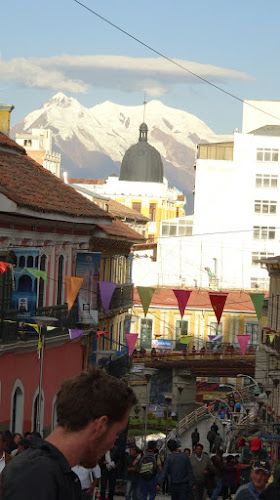The city's name is Our Lady of Peace (Nuestra Señora de La Paz) - but commonly known as La Paz. It is located on the western side of Bolivia at an elevation of roughly 3650 m.
The city sits in a bowl surrounded by the high mountains of the altiplano. As it grew, the city of La Paz climbed the hills, resulting in varying elevations from 3200 to 4100 m. Overlooking the city is the towering 4-peaked extinct stratovolcano Illimani (6438 m) which is always snow-covered and can be seen from many parts of the city.
We had a city tour today, visiting the old town (Casco Viejo) in which is Plaza Murillo which was originally Plaza Major and then in Spanish colonial times was known as Plaza de Armas - as in most Bolivian and Peruvian cities. But following independence, it was renamed the July 16 Plaza (Plaza 16 de Julio) on February 3, 1902, in honour of Pedro Murillo, who was captured and hung by Spanish troops in January 1810.
Prominent buildings on the plaza include the Presidential Palace, the National Congress of Bolivia, and the Cathedral of La Paz. [An interesting sight in the Plaza is the clock in the spire of the Presidential Palace. The clock runs anti-clockwise!]
The plaza was fenced off today and under heavy armed security due to an expected protest. It was a good thing we had Edwin with us who showed his ID and got us in.
Walking on, we stopped so I could buy a humita which I saw in the window of a shop. It is an Andean snack, but common in fact throughout Latin America and has been prepared in Spanish America since pre-Columbian times. It is based on a soft paste made from corn.
We then drove to the Mirador Killi Killi to see the city from a high point. The streets are incredibly steep and the old buses creak up - usually they are Dodges and Chevrolets.
Edwin talked to us about the Cochabamba Water War which was a series of protests that took place in Cochabamba, Bolivia's third largest city, between December 1999 and April 2000 in response to the privatization of the city's municipal water supply company Semapa. The wave of demonstrations and police violence was described as a public uprising against water prices. The James Bond film, 'Quantum of Solace' (2008), involves a wealthy businessman, a member of the Quantum organisation, who intends to stage a coup d'état in Bolivia to seize control of that country's water supply.
We then drove 11 kms to the southern part of the city to visit to the bizarre Moon Valley (Valle de la Luna): a maze of canyons and giant spires. The formations, composed mainly of clay and sandstone, were created by the persistent erosion of mountains by the area’s strong winds and rains.
It is quite warm here: apparently for every 200 m descent, there is a temperature increase of 1 degree C.
We then opt for a cable car ride rather than a visit to a museum. We take the yellow line cable car which goes up to El Alto city at the top of La Paz where the working-class live. The three cable car lines (red, yellow and green - the same colours as in the flag) were built only about 2 years ago for $US234 billion (by Doppelmayer); at the top station it is 4010 m.
We then returned to the central business district where we are staying and walked around the Witches Market (Mercado de las Brujas). Despite the Catholicism the Spanish introduced to Bolivia, an ancient belief system is still strongly in place among the Andean majority. In the market there are shops and street vendors who sell totems, trinkets and talismans meant to appease the gods of the sun and earth: including dead baby llamas with their hollow eyes and ghastly, grimaced mouths. The sheer number of shops speaks to the stubborn persistence of a religion the Catholics weren’t able to uproot, despite their best efforts.
By lunchtime, Edwin finished his tour and we had a free afternoon.
We did a few things like TOP getting a memory card and more Bolivianos from an ATM (Edwin told us that there isn't counterfeit money here!); and then we wandered the markets again looking at foods, hats, gloves, jumpers, etc. They sell EVERYTHING in the market - even toilets of amazing colours. We entertained ourselves in Optica shops where I bought frames to replace my broken reading glasses (I tell you, I am struggling! No doubt there are lots of typos in this blog!). Anyway, 200 Bolivianos (= $US 30 roughly).
Then back to the hotel to sort ourselves out. We have an early start in the morning - earlier even than scheduled due to the flight being earlier now. We go out for dinner for the first time in a few days and have a lovely meal - wild grilled trout and a glass of nice white (Bolivian) sauvignon blanc.
By the way, there are some notorious villains who have a connection with Bolivia:
- Klaus Barbi came to Bolivia; there was a film I think called 'Nazi Hunters' about this. There was a story that Barbie worked with the CIA to capture and kill Che Guevara. Apparently Barbie lived well in Bolivia.
- Butch Cassidy and the Sundance Kid are said to have died in a dusty Bolivian town on Nov. 6, 1908. Historians say they are dead. What refuses to die is the legend that they survived that shootout and lived on.

















The travels up the cable car remind me of Mendoza.
ReplyDelete